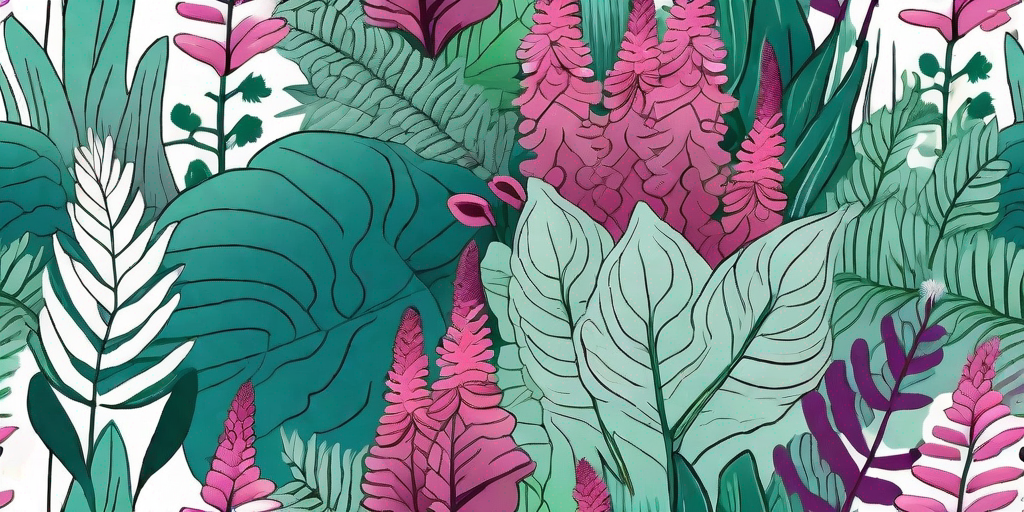
When it comes to creating a blooming garden that's the envy of the neighborhood, choosing the right plant companions is key. And if you're a fan of the astilbe plant, you're in luck! This article will guide you through the process of selecting the perfect companions for your astilbe plants, ensuring a vibrant and thriving garden that's sure to turn heads.
The Astilbe Plant: A Quick Overview
Before we delve into the world of astilbe companions, let's take a moment to appreciate the star of the show. The astilbe plant is a perennial favorite among gardeners, and for good reason. With its feathery plumes and fern-like foliage, this plant is a real showstopper.
Native to Asia and North America, astilbes thrive in shady, moist conditions. They're also deer-resistant, making them a great choice for those who live in areas with a high deer population. But what really sets astilbes apart is their stunning variety of colors, from soft pinks and purples to vibrant reds and whites.
Choosing the Perfect Companions for Your Astilbe Plants
Now that we've sung the praises of the astilbe plant, let's move on to its potential companions. The right companions can enhance the beauty of your astilbes, create a more balanced garden, and even improve the health of your plants.
But how do you choose the perfect companions? Well, it's all about understanding the needs and characteristics of your astilbes, and finding plants that complement them. Here are some factors to consider:
Light Requirements
Astilbes prefer shady to semi-shady conditions. Therefore, it's important to choose companion plants that thrive under similar light conditions. This will ensure that all your plants get the light they need to grow and bloom.
Some shade-loving plants that make great companions for astilbes include hostas, ferns, and heucheras.
Soil and Water Requirements
Astilbes love moist, well-drained soil. So, you'll want to pair them with plants that have similar soil and water needs. This will make it easier for you to maintain your garden and keep all your plants happy.
Some plants that enjoy moist soil include ligularias, rodgersias, and bleeding hearts.
Color and Texture
When choosing companion plants, don't forget to consider aesthetics. Look for plants that will complement the colors and textures of your astilbes. For example, plants with large, bold leaves can provide a nice contrast to the delicate, feathery plumes of astilbes.
Some plants with interesting colors and textures include coral bells, brunneras, and Japanese painted ferns.
Creating a Blooming Garden: Step-by-Step Guide
Now that you know what to look for in companion plants, let's get down to the nitty-gritty: creating your blooming garden. Here's a step-by-step guide to help you get started:
-
Assess your garden: Before you start planting, take some time to assess your garden. Consider factors like light, soil type, and space. This will help you choose the right plants for your garden.
-
Choose your plants: Based on your garden assessment, choose your astilbes and companion plants. Remember to consider light, soil, and water requirements, as well as color and texture.
-
Plan your garden: Once you've chosen your plants, plan out your garden. Consider the height and spread of each plant to ensure a balanced and aesthetically pleasing garden.
-
Plant your garden: Now comes the fun part - planting! Follow the planting instructions for each plant, and remember to give each plant enough space to grow.
-
Maintain your garden: After planting, don't forget to water and fertilize your plants as needed. Regular maintenance is key to a blooming garden.
FAQs
What are some good companion plants for astilbes?
Some good companion plants for astilbes include hostas, ferns, heucheras, ligularias, rodgersias, bleeding hearts, coral bells, brunneras, and Japanese painted ferns.
What conditions do astilbes prefer?
Astilbes prefer shady to semi-shady conditions, and moist, well-drained soil.
Are astilbes deer-resistant?
Yes, astilbes are deer-resistant, making them a great choice for gardens in areas with a high deer population.
Conclusion
Creating a blooming garden with astilbes and their perfect companions is a rewarding endeavor. With the right plants and a little bit of planning, you can create a garden that's not only beautiful, but also easy to maintain. So why wait? Start planning your blooming garden today!
Remember, the journey of a thousand miles begins with a single step... or in this case, a single plant. Happy gardening!















